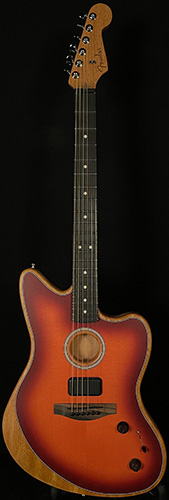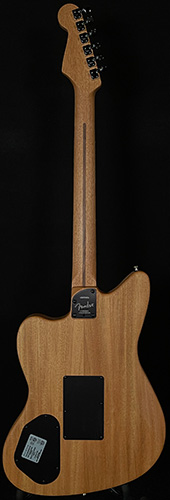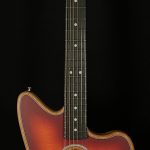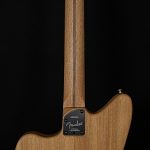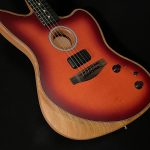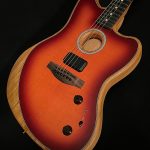Fender American Acoustasonic Jazzmaster
Soul Acoustasonic Force
Who says a Swiss Army knife can’t be deadly? Fender’s new Acoustasonic Jazzmaster certainly is! Designed by the same fellow who came up with the idea for the Taylor T5z, the Acoustasonic Jazzmaster is one of the most versatile, innovative, and inspiring guitars to come out in the last decade. With its state-of-the-art Acoustic Engine (an AMAZING pickup system borne of a collaborative effort between Fender and Fishman) and Fender’s Stringed Instrument Resonance System (SIRS), players are able to experience a wide variety of spectacular acoustic sounds with a mere flick of the wrist. And, should you desire more gristle, the Acoustasonic Jazzmaster comes equipped with an electric guitar pickup that roars with the best of them!
Whether you’re a couch picker, a hard-gigging road dog, or a studio wizard, you’ll find a lot to love about the Acoustasonic Jazzmaster. So, let’s take a closer look and see what makes it so special!
Now I’m a Believer
I have to admit, I felt a mixture of excitement and skepticism when the first batch of Acoustasonic Jazzmasters arrived. My taste in acoustic guitars leans to the traditionalist side of things, but I’m pragmatic enough to enjoy innovative new designs, and the buzz about these guitars was approaching fever pitch. Could they compete with big-bodied acoustics? Could they hang with electrics? Could they truly deliver the goods? I hoped so, but I had a few nagging doubts.
It took only a few minutes for me to see the light and become a believer. Certainly, their innovative electronics are responsible for much of the Acoustasonic’s delights but before I get into that, I want to stress just how well they function as straight-up acoustic guitars. After I tuned one of these bad boys up for the first time, I started playing a couple of licks, and pretty soon half an hour had passed and I hadn’t even plugged the amp in!
When I finally got around to amplifying myself, I was absolutely blown away by Fender and Fishman’s Acoustic Engine. It truly changes the game for plugged-in acoustic sounds, so let’s take a deeper dive and see how it makes the Acoustasonic Jazzmaster the most dangerous Swiss Army knife out there.
The Little Acoustic Engine That Could
A few years back, Fishman developed a DI pedal called the Aura that solved a problem that has vexed acoustic players for decades: how do you make an acoustic guitar sound natural when you’re playing live? Fishman’s answer was to take samples of legendary acoustic guitars recorded with nice mics and develop what they call “images” of the guitars. They used these images to create algorithms that cause the input signal to mimic the sonic characteristics of each venerated acoustic. Basically, the pedal did two things: it could make a plugged-in D-18 sound like a mic’d up D-18 (which is a HUGE difference), or it could make that same D-18 sound like, say, a mic’d up L-00.
Fender spent countless hours working with Fishman to take this Aura technology to new levels of greatness. The pickup system has three elements: a Tim Shaw-designed humbucker that provides the electric voices, an undersaddle Fishman pickup that provides most of the acoustic tone, and the Fishman Acoustasonic Enhancer, a pickup used on several settings that follows the top’s movement to allow for greater dynamic response. Best of all, these pickups don’t even require a battery to work! You can charge the pickups using a regular mini USB cable, and one four-hour charge will net you about 20 hours of playtime.
From there, the signal hits the Acoustic Engine, which gives you ten unique acoustic images to pick from. That may seem like a lot, but Fender and Fishman have done a marvelous job of making the Acoustic Engine easy to use. Let’s take a look under the hood and see what inspiring tones we can find!
A V-10 of Tone
Before we get started, let’s address the question that is almost certainly bursting forth from your brain: how do you toggle between so many tones with such simple controls? Well, think of the Acoustic Engine as a V-10 engine: a complex machine, certainly, but all the driver has to worry about is putting the key in the ignition. Accessing the ten different tones requires only two knobs and a 5-way switch, and it couldn’t be simpler. The knob closest to the soundhole is for volume, and the other one is called the “Mod” knob. It interacts with the five-way switch to give you more options.
Position 5a: Dreadnought with rosewood back and sides
Position 5b: Slope-Shoulder Dreadnought with mahogany back and sides
Position 4a: Jumbo with mahogany back and sides
Position 4b: All-mahogany small-body
Position 3a: Auditorium with rosewood back and sides.
Position 3b: Acoustasonic's body sensor engaged so you can use the top for percussive effect.
Position 2a: Lo-fi piezo
Position 2b: Lo-Fi piezo crunch
Position 1a: Fender electric fat/semi-clean
Position 1b: Fender overdriven clectric
Almost a Spitting Image
Before we go any further, it’s important to address a question that is no doubt bubbling forth from your consciousness: how close does the Acoustic Engine get to the sound of the instruments it pays homage to? I’ll put it this way: the Acoustasonic Jazzmaster isn’t going to make you want to sell your Taylor 814ce, or your D-18, or your Jazzmaster. But, it sounds close enough that each image can still compel you to lose yourself in the music, and that’s what counts. It certainly doesn’t feel like you’re playing a Thinline acoustic, that’s for sure! It’ll never sound quite as rich as a vintage D-28, but it’s not supposed to. It’s supposed to be a Swiss Army knife that provides lots of spectacular flavors of acoustic tone in one box, and it accomplishes that with great aplomb.
Dangerously Playable
But, the Acoustic Engine isn’t the only thing that makes these instruments exceptional. The Acoustasonic Jazzmaster is also addictive sans electricity for two reasons: spectacular handfeel and the Stringed Instrument Resonance System. The handfeel part is easy to explain: it comes equipped with a modern deep C-shaped neck profile similar to the one you’d find on a production model USA-made Fender electric. It has a 12” radius, which allows for low setups and easy bending, and narrow-tall frets. Narrow-tall frets are wonderful because they make bending easier and generally allow you to expend less effort with your left-hand.
In the end, it feels like you’re playing an electric guitar with thicker strings. You have to work for it (the Acoustasonic Jazzmaster does come equipped with 12-gauge strings), but you can still perform big bends and all your other typical electric guitar moves. It really is an acoustic that feels like an electric—a godsend for players doing long acoustic gigs!
Thank you SIRS, May I Have Another?
Fender’s Stringed Instrument Resonance System is an impressive feat of design that allows the Acoustasonic Jazzmaster to project enough to compete with other acoustic instruments in an unplugged jam. The design is genius. Fender’s luthiers hollow out a solid piece of mahogany using a CNC machine for maximum precision, but they leave a lip on upon which they fix the solid spruce top. Because this lip offers so much stability and support, they don’t need to use much bracing—just two transverse braces. The lighter the bracing, the more responsive the guitar is. And, its all-solid wood construction gives it a sweet, woody, midrange-forward tone, and the light bracing makes it quite dynamic and articulate.
But, it doesn’t lose volume due to its light bracing because the soundhole port essentially functions as a speaker horn. So, while the Acoustasonic Jazzmaster’s resonance may not compete with that of a dreadnought, it will certainly cut through enough to be heard if you’re jamming unplugged. And, it will still capture the nuances and details of your playing faithfully.
An Inspiration Machine
I’ve been struggling to find a way to summarize my thoughts on the Acoustasonic Jazzmaster. I’ve spent my whole eight-hour day writing about it thus far, and I have lots of important Big Ideas about how it will revolutionize live acoustic performance and make life easier in the studio. But I think the best encapsulation of the Acoustasonic Jazzmaster’s merits is much simpler. I’ve been playing this guitar all day today (y’know, I’ve gotta do my due diligence and properly research my subject), and I’ve had about ten new ideas for riffs pop out of my hands. That right there is the magic of this guitar: it is an unstoppable inspiration-creating machine!
So, is it an acoustic or an electric? Who cares! It’s a wonderful machine that will surely inspire all sorts of new ideas in your playing, and it’s supremely practical for live and studio use. Wildwood Guitars is proud to showcase such an innovative instrument, and we know the Acoustasonic Jazzmaster will inspire you to reach new heights on your fretboard journey.
Specifications:
| Brand | Fender |
|---|
| Model | American Acoustasonic Jazzmaster |
|---|---|
| Finish Color | Tobacco Sunburst |
| Finish Type | Polyester Satin Matte |
| Weight | 5.49 lbs. |
| Top Wood | Solid Spruce |
| Body Wood | Solid Mahogany |
| Neck Wood | Mahogany |
| Neck Shape | Modern Deep C |
| Neck Dimensions | .820 1st - .930 12th |
| Fingerboard | Ebony |
| Fingerboard Radius | 12" |
| Nut Material | Graph Tech Tusq |
| Nut Width | 1.6875" |
| Frets | 22 Narrow-Tall |
| Pickups | Fishman Acoustic Engine, Tim Shaw-Designed Humbucker |
| Controls | 1 Volume, 1 Mod Knob, 5-Way |
| Hardware | Nickel/Chrome |
| Tuners | Vintage-Style with Fender Logo |
| Bridge | Modern Asymetrical |
| Case | Padded Fender Gig Bag |
| COA | Yes |
Why Order from Wildwood Guitars?
An instrument from Wildwood isn't just an ordinary guitar. It's your guitar. Each and every instrument we sell includes a full, point by point setup, an exhaustive evaluation, and expert shipping procedures, with first class, industry leading standards from start to finish. Why? Because you deserve it.Click Here to learn more about what makes a Wildwood instrument so special...



